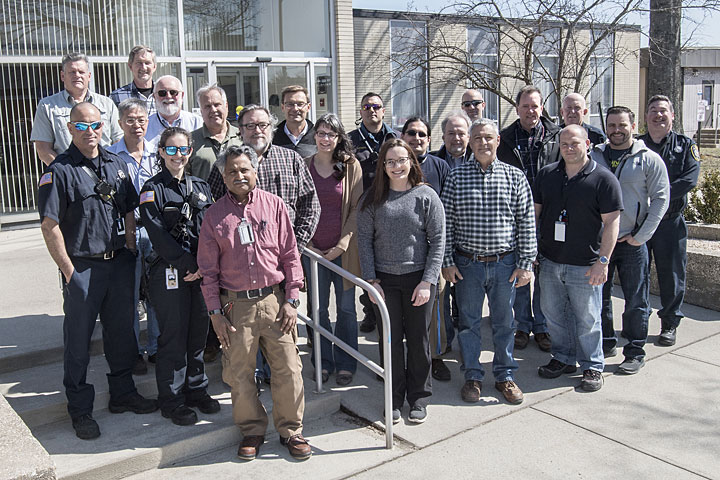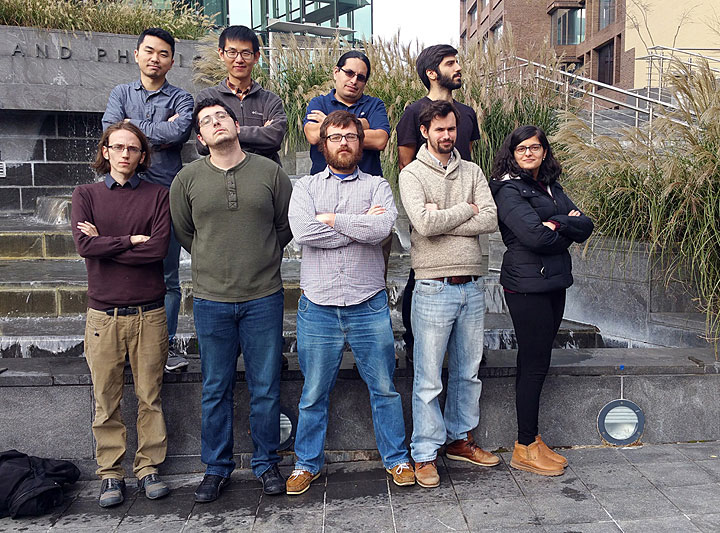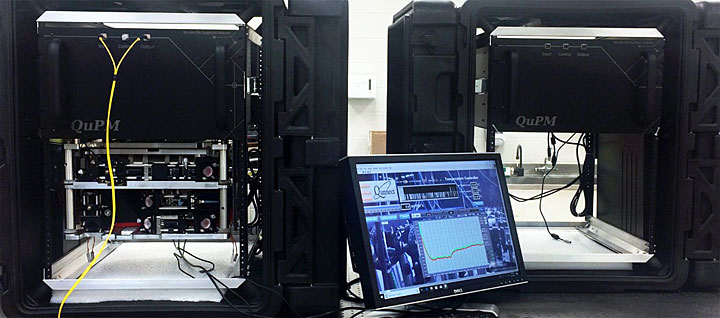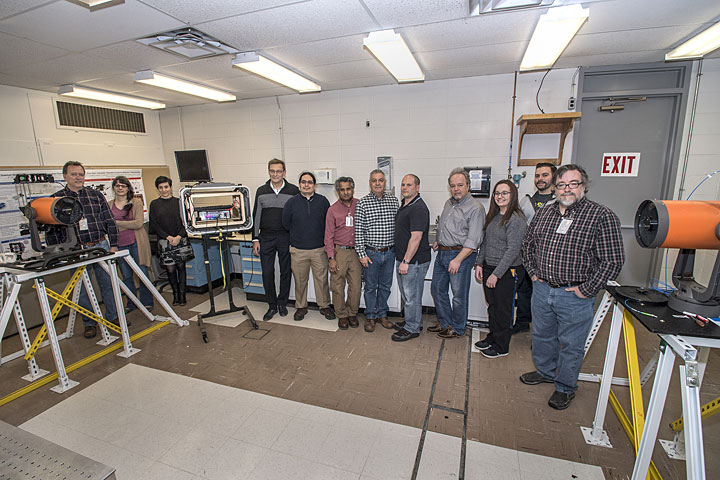Building a Network for Long-Distance Quantum Communication
Brookhaven Lab and Stony Brook University are developing a quantum networking testbed to explore the creation of a quantum internet
August 5, 2019
 enlarge
enlarge
A team of computational and computer scientists, networking engineers and technicians, physicists, astronomers, and fire rescue personnel from Brookhaven Lab and Stony Brook University hope to build the world's first true quantum internet. To do so, they will need to figure out how to store and transfer quantum bits, or qubits—the analogue of the bits used in today's computers—over long distances. Clockwise from left back row: William King, William Smith, John McGowan, Ronald Angona, Paul Stankus, Andrei Nomerotski, Justine Haupt, Thomas Sidik, Eden Figueroa, Dimitrios Katramatos, James Schmidt, Michael O'Connor, Gary Schaum, Mark Lukasczyk, Lee Brett, Joseph Maietta, Michael Attanasio, Abbi Elger, Anand Kandasamy, Aubrie Andenmatten, James Maire, and Thomas Tsang.
From the rooftop of the decommissioned Brookhaven Graphite Research Reactor (BGRR) at the U.S. Department of Energy’s (DOE) Brookhaven National Laboratory, the Health Sciences Tower at Stony Brook University (SBU)—approximately 13 miles away—is clearly visible. With this clear line of sight, scientists at Brookhaven Lab and SBU hope to establish a quantum channel over which single particles of light (photons) can be sent between the two institutions in open air. Following this proof-of-concept demonstration, they want to scale the network to operate over longer distances through the fiber-optic cables that support much of our telecommunications and data networking today. Building such a quantum internet would not only provide more speedy, reliable, and secure information transfer but also help connect geographically distributed quantum computers to solve complex problems in science and other areas.
 enlarge
enlarge
The Health Sciences Tower at SBU is clearly visible (50x zoom) from the BGRR rooftop. Scientists hope to take advantage of this clear line of sight to send single particles of light in open air as a proof-of-concept demonstration for quantum communication.
“It would be prohibitively expensive to build a new infrastructure just for quantum networking,” explained Dimitrios Katramatos, a technology architect in Brookhaven Lab’s Computational Science Initiative (CSI). “Updating existing connections so that they are quantum enhanced is more feasible from this perspective. But the question is, how do we do that?”
Eden Figueroa—who holds joint appointments as a scientist in Brookhaven Lab’s Instrumentation Division and CSI, and as a professor in SBU’s Department of Physics and Astronomy and head of the Quantum Information Technology Group—has some ideas. Since his PhD days, he has been developing the devices necessary for a quantum internet. These technologies include room-temperature quantum memories—the main elements necessary to store and retrieve quantum information—based on rubidium atoms, and quantum repeaters for extending the range of signal transmission.
“We’re now at the point where we have all of the components necessary for a quantum network and are ready to start building one and testing its performance for different communication tasks,” said Figueroa, who is also the scientific lead at the small business Qunnect, which is developing and commercializing the room-temperature quantum memories.
Figueroa first began collaborating in this area with Brookhaven Lab nearly two years ago when he met Andrei Nomerotski, a physicist in the Lab’s Cosmology and Astrophysics Group, at a workshop focused on silicon detectors. At the time, Nomerotski was building an ultrafast camera called TimepixCam in his Fast-Imaging Lab in Brookhaven’s Physics Department. This camera, which has since been upgraded to Tpx3Cam, has a silicon sensor that efficiently converts incoming photons into readable signals and a readout chip—developed at the European particle physics laboratory CERN—that measures time with nanosecond resolution. Equipped with an appropriate image intensifier, Tpx3Cam is capable of imaging single photons. With this capability, Tpx3Cam can be used to image pairs of entangled photons, which many scientists believe are prime candidates for qubits—quantum bits, the counterpart of the binary bits (which have a value of either a 0 or 1) that carry information in today’s computers. But the first step in exploring this possibility is determining whether the photons are entangled in the first place. Here is where the Brookhaven and SBU scientists think the camera can be useful.
 enlarge
enlarge
The Stony Brook Quantum Information Group. Upper row (from left to right): Young Shing Kim (PhD student), Guodong Cui (PhD student), Eden Figueroa (principal investigator), and Samet Demircan (PhD student). Lower row (from left to right): Steven Sagona (PhD student), Christopher Ianzano (master's student), Bertus Jordaan (PhD student), Mael Flament (PhD student), and Sonali Gera (PhD student). This team of researchers developed a technology that uses quantum memory applications at room temperature to securely store and transfer information. Credit: Stony Brook University.
Entangled photons
Photons become entangled when two photons are created at the same time and location in space. They correlate their properties and behaviors such that a measurement of one photon immediately influences the state of the other, even when they are separated by vast distances (Photons exist in all possible states simultaneously—0s and 1s—until they are observed or measured, at which time they exhibit only a single state).
Scientists hope to take advantage of this strange quantum phenomenon of entanglement to “teleport” quantum information from one place to another over long distances without signal degradation. This teleportation would enable new ways for scientists to conduct large experiments with exquisite precision and powerful distributed computing capabilities.
“Quantum teleportation is very interesting in the context of quantum computing and communication,” said Figueroa. “If we can connect quantum computers at different locations, we will be able to distribute qubits and perform computations using shared entangled states. Furthermore, a quantum network of devices could lead to a new generation of experiments that are more sensitive to gravitational waves and dark matter, for example.”
 enlarge
enlarge
Because of losses introduced during transmission, direct quantum communication in fiber-optic cables is currently limited to distances of about 100 miles. Building a true global quantum network will require the development of technology to regenerate the quantum signals. Credit: Mael Flament, Stony Brook University.
In principle, there should be no maximum distance over which teleportation can occur. However, when entangled photons travel in the atmosphere or inside optical fibers, entanglement can be lost before the photons reach their final destination. Thus, the distance over which entanglement can be measured or teleportation performed has been limited. Physicists in China recently transmitted entangled photons between ground stations and a satellite in orbit separated by a record-breaking distance of nearly 900 miles.
However, this experiment was based on the direct propagation of photons.
“Such point-to-point quantum links can be used to transmit quantum keys to encode and send information to decrypt a message,” said Figueroa. “What has never been done before is to distribute entanglement over thousands of kilometers. This distribution requires “regenerating” the quantum information.”
According to Figueroa, the only way to regenerate the quantum information is through quantum memory devices.
“Photons move very fast, at the speed of light,” explained Figueroa. “But computer memories are static. You need to “grab” the photons and exchange them into something static.”
One approach is to transfer the quantum information carried by photons to atoms that are static. But manipulating the state of atoms at the quantum level is not easy. It requires lasers of the appropriate wavelength to control the atoms in such a way that the photons can be “caught” without losing any of their information. In addition, the quantum memory devices must be built in a compact way so that they can be used in the real world.
Over the past decade, Figueroa has been developing this technology. Within this time, he and his team managed to reduce the dimensions of the devices from lab to shoebox size. They are currently developing relay devices called repeaters to recreate the entangled states so that they can survive longer distances across the network.
 enlarge
enlarge
The latest model of the fully portable room-temperature quantum memory devices, which are installed in the new Quantum Information Science and Technology Laboratory in Brookhaven Lab's Instrumentation Division. Credit: Mael Fament, Stony Brook University.
At Brookhaven, the scientists will construct an entangled photon source that will allow them to interface with the atoms and feed them into the large network of optical components. For their experiments, they will use rubidium atoms to store photons.
“Rubidium atoms only have one electron in their outer core, so the energy levels are easily accessible for our experiments,” explained Figueroa.
 enlarge
enlarge
Experimental layout for photon entanglement generation and characterization. (Left) The source utilizes a blue laser (405 nanometers) and a pair of barium borate (BBO) crystals to generate signal and idler photons entangled in polarization; these photons are then fiber coupled. (Right) Exiting from the fibers, the photons are detected by an image intensifier before being registered by the Tpx3Cam. Courtesy of Andrei Nomerotski and Eden Figueroa.
First experiments
For their initial quantum entanglement experiments, the scientists are using a source of entangled photons installed within a server rack in the Brookhaven Scientific Data and Computing Center (SDCC), where the Lab’s primary networking hub is located. This source produces photon pairs, with one photon going to a fiber in Nomerotski’s lab and the other to a fiber in Figueroa’s Quantum Information Science and Technology (QIST) Laboratory, where they are detected with fast cameras. The QIST Lab is a new quantum research facility in Brookhaven’s Instrumentation Division that is under development by a team including design engineer Justine Haupt, physicist Paul Stankus, and physicist Thomas Tsang. The first phase of construction has already been completed, and initial experiments in quantum entanglement characterization, quantum memory construction, and free-space link prototype development are ongoing.
To run the fibers to Nomerotski’s and Figueroa’s labs, staff from Brookhaven’s Information Technology Division Network Services used the existing campus network infrastructure and standard telecommunication components. With this networking completed, the experiments were ready to commence.
Using devices called polarimeters, the scientists are first measuring the polarization (direction) of the photons to prove they are entangled. Photons that arrive in each lab at the same time and have correlated polarizations are entangled. Nomerotski and Peter Švihra—his collaborator from the University of Manchester in the UK—are currently in the process of synchronizing two cameras separated by a one-mile distance and analyzing the data so that time can be measured precisely at the subnanosecond level.
“We need to find coincident photons, or those that come to the cameras simultaneously, and characterize these photons as a function of their polarization,” explained Nomerotski.
 enlarge
enlarge
(Left to right) Mark Lukasczyk, Gabriella Carini, Dimitrios Katramatos, Justine Haupt, Abbi Elger, Andrei Nomerotski, Paul Stankus, Anand Kandasamy, Eden Figueroa, Michael Attanasio, Michael O'Connor, and Joseph Maietta in the QIST Lab in Brookhaven's Instrumentation Division. They used an intensified fast camera controlled by a laptop to timestamp and measure the rates of photons coming from Brookhaven's Information Technology Division through existing fiber infrastructure. Behind the laptop is a setup for measuring the polarization of entangled photons.
The scientists are also conducting experiments to determine losses and noise. They recently determined that the main problem seems to be noise coming from various light sources along the path of the fibers. The fiber jackets that enclose the fibers and the connectors linking the different fibers together are not 100-percent lightproof.
“A lot of photons seep in through the connectors and even the jackets,” said Katramatos. “At the single-photon level, this noise can overwhelm the detectors. So, we needed to come up with quick, temporary fix to reduce it. Our solution included wrapping certain segments with tape, and we were able to prove that we can use the existing fiber infrastructure. In future experiments, we plan to use armored fibers wherever there is significant light exposure.”
Initially, the team established a short-distance (about one mile) quantum link between SDCC and the two labs. DOE’s Energy Sciences Network (ESnet)—a high-speed network linking researchers worldwide—provided the scientists with 12 fiber pairs from its Brookhaven Lab infrastructure that they then spliced together to form loops, gradually increasing this distance to more than 25 miles on site. Michael O’Connor, an ESnet optical network specialist at Brookhaven, has been instrumental in this effort, proposing the loop idea and helping the team implement it.
Extended distances
The next step for the scientists is to extend this local Brookhaven connection to SBU, where a similar local area quantum network with quantum memories and entangled sources already exists.
 enlarge
enlarge
On the other side of the QIST lab are prototype devices for the free-space link under construction. Two telescopes will be pointed at each other in the configuration seen here in proof-of-concept demonstrations to send single photons in open air from Brookhaven Lab to SBU. Left to right: Michael O'Connor, Justine Haupt, Gabriella Carini, Andrei Nomerotski, Eden Figueroa, Anand Kandasamy, Michael Attanasio, Joseph Maietta, Dimitrios Katramatos, Abbi Elger, Mark Lukasczyk, and Paul Stankus.
“The quantum memories we are going to use require light of a certain wavelength, about 800 nanometers,” said Nomerotski. “This wavelength is not optimal for fiber propagation using the existing infrastructure of optical cables because these cables have minimum losses in the neighborhood of 1550 nanometers.”
“If you use infrastructure designed to work at almost twice the wavelength, you get very high losses that are a major limiting factor for quantum communications,” added Katramatos. “As you increase the distance, this problem only gets worse. That is why we need to build quantum repeaters.”
In preliminary long-distance quantum communication experiments, the scientists are initially exploring a free-space quantum channel between Brookhaven and SBU that will use sophisticated telescopes to send the single photons. This link will enable several critical quantum experiments between Brookhaven and SBU and proof-of-concept demonstrations as the technology for longer-distance quantum communications over fiber is being developed. In the near term, a fiber link between Brookhaven and SBU using the existing fiber infrastructure of local providers is also being considered.
 enlarge
enlarge
Support from Brookhaven's Fire Rescue Group was critical in making the determination that the top of the BGRR was a suitable location to establish the free-space link between Brookhaven and SBU.
Because a clear line of sight is required for the free-space link to operate, the scientists had to survey candidate locations at both institutions. As one of the highest points on Long Island, the Health Sciences Tower at SBU was an obvious choice. At Brookhaven, eight different locations were surveyed with the help of Brookhaven’s Fire Rescue Group, which provided their ladder truck and authorized personnel. After an on-the-spot survey with the help of the Groundwater Protection Group confirmed the existence of line of sight, the top of the BGRR building was ultimately selected.
“Accessibility to do proof-of-concept experiments and adequate space to accommodate the prototype optics and enclosures that protect the optics from the environment were among the requirements,” said Brookhaven Lab spectrum manager Anand Kandasamy. “We spent several hours surveying possible locations, and the effort would not have been possible without the help of the Fire Rescue team and their 95-foot ladder truck, and Instrumentation Division technical associate William Smith, who accompanied the firefighters in the ladder truck bucket.”
While the free-space link avoids losses associated with using the existing infrastructure, it does present other challenges. Any movement, including fine vibrations and atmospheric disturbances such as wind, can easily cause the optics to go out of alignment.
“We need to have adaptive optics to account for the movement resulting from turbulence in the atmosphere,” said Nomerotski. “Learning how to do that may require the expertise of astrophysicists and the use of telescopes in an atypical configuration—looking sideways to collect light coming from a source—say Brookhaven Lab—instead of looking up at the sky.”
 enlarge
enlarge
The team plans to gradually increase the distance of the quantum communication network. Initially, they will try to link Brookhaven Lab's local quantum network to quantum networks at Stony Brook University and the Center of Excellence in Wireless and Information Technology (also located in Stony Brook). The atom symbols represent atomic memories, and the infinity symbols represent quantum entanglement.
Ultimately, the scientists seek to achieve long-distance connectivity, transmitting quantum information over hundreds of miles. After a link between Brookhaven and SBU has been demonstrated, they will try to extend it to campuses around the region and to the Manhattan Landing (MAN LAN)—a networking exchange point in New York City that connects several large networks, including ESNet—and the New York State Education and Research Network (NYSERNet). If successful, the scientists would be the first in the United States to develop a distributed quantum processing network using entanglement.
“What will network protocols and devices look like for quantum communication?” said Katramatos. “How do you sit down at your quantum computer and talk to the quantum world? How do you interface between quantum and classical networks? These are all open questions in science, which we will try to answer with our networking testbed.”
“Teams in Europe and in China are trying to solve the very same problems,” said Figueroa. “In order to win the technological race to develop the quantum internet, we will need the combined the expertise of networking engineers and technicians, scientists who can provide us with detection systems, and astronomers who can teach us how to use telescopes and detect light at a very low level with high efficiency.”
This work is supported by a DOE Laboratory Directed Research and Development award, Brookhaven Lab program development funds, seed funding from Stony Brook University, the National Science Foundation, a DOE Small Business Innovation Research program awarded to Qunnect, and the Empire State Development Corporation.
Brookhaven National Laboratory is supported by the Office of Science of the U.S. Department of Energy. The Office of Science is the single largest supporter of basic research in the physical sciences in the United States, and is working to address some of the most pressing challenges of our time. For more information, please visit https://energy.gov/science.
Follow @BrookhavenLab on Twitter or find us on Facebook.
2019-13229 | INT/EXT | Newsroom









